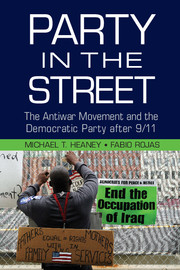Book contents
- Frontmatter
- Dedication
- Contents
- List of Tables
- List of Figures
- List of Abbreviations
- Introduction
- 1 The Party in the Street and Its Historical Context
- 2 Partisan Politics at the Water's Edge?
- 3 Multiple Identities and Party-Movement Interaction
- 4 Identities and Grassroots Participation
- 5 Identities and Organizational Action
- 6 Identities and Legislative Agendas
- 7 Beyond the Antiwar Movement and the Democratic Party
- 8 Social Movements in a Polarized America
- Epilogue
- Appendixes
- References
- Index
Introduction
Published online by Cambridge University Press: 05 February 2015
- Frontmatter
- Dedication
- Contents
- List of Tables
- List of Figures
- List of Abbreviations
- Introduction
- 1 The Party in the Street and Its Historical Context
- 2 Partisan Politics at the Water's Edge?
- 3 Multiple Identities and Party-Movement Interaction
- 4 Identities and Grassroots Participation
- 5 Identities and Organizational Action
- 6 Identities and Legislative Agendas
- 7 Beyond the Antiwar Movement and the Democratic Party
- 8 Social Movements in a Polarized America
- Epilogue
- Appendixes
- References
- Index
Summary
January 27, 2007, was an unseasonably warm Saturday in Washington, D.C. With the sun shining and afternoon temperatures reaching 57 degrees Fahrenheit, the weather conditions were perfect for an antiwar march in the nation's capital. The political conditions seemed perfect, too. Only a few months earlier, on November 7, 2006, the Democratic Party had won a decisive victory in the congressional midterm elections. Democrats gained thirty-one seats in the U.S. House of Representatives and six seats in the U.S. Senate, allowing them to control both the House (by a 233–202 margin) and the Senate (by a 51–49 margin) for the first time since 1994 (CNN 2006; Zelney and Zernike 2006). Media accounts of the election widely attributed the outcome to voters' dissatisfaction with President George W. Bush and the Iraq War (see, for example, Dewan 2006).
Leaders in the antiwar movement sought to seize the political opportunity created by the Democrats' return to power. Given the belief that Democrats owed their victory to antiwar sentiment, movement activists hoped to press Democratic leaders into bringing the Iraq War to a quick end. To support this goal, upward of one hundred thousand people gathered at the National Mall for a rally organized by United for Peace and Justice, the nation's largest and broadest antiwar coalition during the presidency of George W. Bush. The rally focused on the slogan “The voters want peace. Tell the new Congress: ACT NOW TO END THE WAR!” (United for Peace and Justice 2007d, emphasis in original). The speakers included elected officials from the Democratic Party, such as U.S. Representatives Dennis Kucinich (D-OH), Maxine Waters (D-CA), and Lynn Woolsey (D-CA); movement leaders, such as the Reverend Jesse Jackson and Medea Benjamin; and celebrities, such as Jane Fonda and Danny Glover, all of whom echoed the view that the 2006 elections were a mandate for peace. As U.S. Representative Lynn Woolsey exclaimed in her remarks, “We have an antidote to this insanity.… It is what you sent us to do last November. It's called H.R. 508 … the Bring [the] Troops Home and Iraq Sovereignty Restoration Act” (Woolsey 2007b, emphasis in original).
- Type
- Chapter
- Information
- Party in the StreetThe Antiwar Movement and the Democratic Party after 9/11, pp. 1 - 13Publisher: Cambridge University PressPrint publication year: 2015



